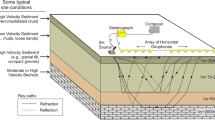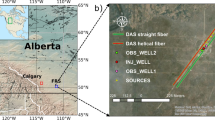Abstract
The Deep-towed Acoustics and Geophysics System (DTAGS) is a high frequency (220–820 Hz) multichannel seismic system towed about 300 m above seafloor. Compared to the conventional surface-towed seismic system, the DTAGS system is characterized by its shorter wavelength (<6 m), smaller Fresnel zone, and greater sampling in wavenumber space, so it has unique advantages in distinguishing fine sedimentary layers and geological structures. Given the near-bottom configuration and wide high-frequency bandwidth, the precise source and hydrophone positioning is the basement of subsequent seismic imaging and velocity analysis, and thus the quality of array geometry inversion is the key of DTAGS data processing. In the application of exploration for marine gas hydrate on mid-slope of northern Cascadia margin, the DTAGS system has shown high vertical and lateral resolution images of the sedimentary and structural features of the Cucumber Ridge (a carbonate mound) and Bullseye Vent (a cold vent), and provided abundant information for the evaluation of gas hydrate concentration and the mechanism of fluid flow that controls the formation and distribution of gas hydrate.
Similar content being viewed by others
References
Collett T S. Resource potential of marine and permafrost associated gas hydrates. In: Max M D, Pallenbarg R E, Rath B B, eds. Oceanic Gas Hydrate: Guidance for Research and Programmatic Development at the Naval Research Laboratory. Proceedings of the Workshop on Naval Research Laboratory Gas Hydrate Research Program, NRL/MR/6100-97-8124. Washington D.C.: Naval Research Laboratory, 1997. 24–33
Kvenvolden K A. Methane hydrate—A major reservoir of carbon in shallow geosphere. Chem Geol, 1988, 71: 41–51
Kvenvolden K A. Gas hydrates as a potential energy resource—A review of their methane content. In: Howell D G, ed. The Future of Energy Gases-U.S. Geological Survey Professional Paper 1570, 1993. 555–561
Shine K P, Derwent, R G, Wuebbles D J, et al. Radiative forcing of climate. In: Houghton J, Jenkins G J, Ephraums J J, eds. Climate Change—The IPCC Scientific Assessment. New York: Cambridge University Press, 1990. 41–68
Mciver R D. Role of naturally occurring gas hydrate in sediment transport. AAPG Bull, 1982, 66: 789–792
Davis E E, Hyndman R D. Accretion and recent deformation of sediments along the northern Cascadia subduction zone. Geol Soc Am Bull, 1989, 101: 1465–1480
Hyndman R D, Spence G D. A seismic study of methane hydrate marine bottom-simulating reflectors. J Geophys Res, 1992, 97: 6683–6698
Haacke R, Westbrook G, Hyndman R. Formation of the bottom-simulating reflector and its link to vertical fluid flow. In: Dallimore S R, ed. Proceedings of the 6th International Conference on Gas Hydrates (ICGH 2008), Vancouver, British Columbia, Canada, 2008
Hyndman R D, Davis E E. A mechanism for the formation of methane hydrate and seafloor bottom-simulating reflectors by vertical fluid expulsion. J Geophys Res, 1992, 97: 7025–7041
Riedel M, Collett T S, Malone M J. Proceedings of the Integrated Ocean Drilling Program, Vol. 311. Integrated Ocean Drilling Program Management International Inc, 2006
He T, Spence G D, Wood W T, et al. Imaging a hydrate-related cold vent offshore Vancouver Island from deep-towed multichannel seismic data. Geophysics, 2009, 74: B23–B36
Gettrust J F, Wood W T, Spychalski S E. High-resolution MCS in deepwater. Leading Edge, 2004, 23: 374–377
Spence G, Coffin R, Hoehne J. VENTFLUX2: Report of PGC01-03, C. C. G. vessel John P. Tully, 23 July-12 August 2001. University Victoria, 2002
Gettrust J, Chapman R, Walia R, et al. High resolution seismic studies of deep sea gas hydrate using the DTAGS deep towed multichannel system. EOS, Trans Am Geophys Union, 1999, 80: 439–440
Walia R, Hannay D. Source and receiver geometry corrections for deep towed multichannel seismic data. Geophys Res Lett, 1999, 26: 1993–1996
Rowe M M, Gettrust J F. Fine structure of methane hydratebearing sediments on the Blake Outer Ridge as determined from deep-tow multichannel seismic data. J Geophys Res, 1993, 98: 463–473
He T, Spence G D, Riedel M, et al. Fluid flow and origin of a carbonate mound offshore Vancouver Island: Seismic and heat flow constraints. Mar Geol, 2007, 239: 83–98
Gorman A R, Holbrook W S, Hornbach M J, et al. Migration of methane gas through the hydrate stability zone in a low-flux hydrate province. Geology, 2002, 30: 327–330
Baba K, Yamada Y. BSRs and associated reflections as an indicator of gas hydrate and free gas accumulation: An example of accretionary prism and forearc basin system along the Nankai Trough, off central Japan. Resour Geol, 2004, 54: 11–24
Wood W T, Gettrust J F, Chapman N R, et al. Decreased stability of methane hydrates in marine sediments owing to phase-boundary roughness. Nature, 2002, 420: 656–659
Wood W T, Hart P E, Hutchinson D R, et al. Gas and gas hydrate distribution around seafloor seeps in Mississippi Canyon, Northern Gulf of Mexico, using multi-resolution seismic imagery. Mar Petrol Geol, 2008, 25: 952–959
Chapman N R, Gettrust J F, Walia R, et al. High-resolution, deep-towed, multichannel seismic survey of deep-sea gas hydrates off western Canada. Geophysics, 2002, 67: 1038–1047
Author information
Authors and Affiliations
Corresponding author
Rights and permissions
About this article
Cite this article
Kong, F., He, T. & Spence, G.D. Application of deep-towed multichannel seismic system for gas hydrate on mid-slope of northern Cascadia margin. Sci. China Earth Sci. 55, 758–769 (2012). https://doi.org/10.1007/s11430-012-4377-4
Received:
Accepted:
Published:
Issue Date:
DOI: https://doi.org/10.1007/s11430-012-4377-4




